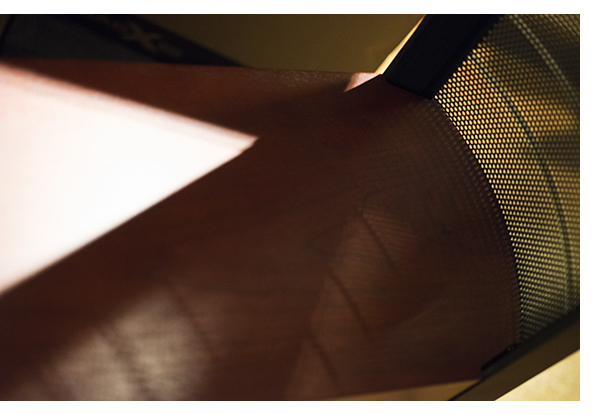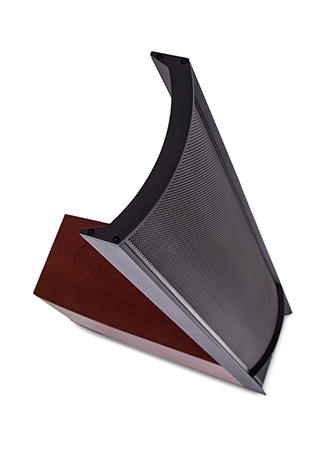The MartinLogan Classic ESL 9 Speakers A Worthy Successor
By Jeff Dorgay Starting this speaker review as I do with nearly every other one with Aimee Mann’s “This is How it Goes,” I’m pretty excited about the Classic ESL 9 from MartinLogan.
Starting this speaker review as I do with nearly every other one with Aimee Mann’s “This is How it Goes,” I’m pretty excited about the Classic ESL 9 from MartinLogan.
To be fair to those of you that might be tuning in for the first time, I love the character of electrostatic speakers. I’ve owned, reviewed, or auditioned nearly every one over the past 30 years, and have spent a fair amount of time in the listening chair with Magnepan and Apogees. My current reference ESLs happen to be the current Quad 2812s (and don’t even get me started on the legendary Quad 57) which are priced at about $10k/pair, and we recently reviewed the $14,995/pair of ML Impression ESL 13A speakers.
Everyone likes something different, but the smooth, slightly diffuse, fill the room character of an electrostatic is tough to ignore. They paint a big, broad, sonic landscape in your room, provided you have enough space to let them breathe. One of the shortcomings of an electrostatic speaker is they tend to paint a vivid, yet small spot for optimum listening. MartinLogan has gone a long way at minimizing this with their curved electrostatic panel, (CLS X Stat to be exact) which broadens the sweet spot beyond what a flat panel can achieve.
MartinLogan’s early CLS from the mid-80s is where my journey with the brand began, and shortly after that a pair of hybrid Sequels took over when my listening room was downsized. The original Sequel (and later Sequel 2) cemented MartinLogan’s reputation as an audiophile speaker and to so many music lovers and audio writers alike became one of the products often referred to as a “giant killer.” They did not have the extension of a massive pair of floorstanders, yet they gave so much more of a window into the music than Magnepans of the day did, while being far more amplifier friendly than the fussy, full ribbon Apogee speakers were.
Past to present
The small (for MartinLogan) Sequel featured a 10-inch ESL panel and a 10-inch woofer in a cabinet nearly six feet tall. The original Sequels were $1,995 and the final Sequel 2, $2,495. A cursory glance at an online inflation calculator reveals that $2,495 in 1987 is about $5,500 in todays wallet. Considering the improvements made in 31 years, I deem the ESL 9 a major bargain and worthwhile upgrade for $6,495.
Pinching a pair of Sequel 2s from a close audio bud reveals a solid foundation to the original. The guys from Kansas were truly on to something back then. And as now, the sound from a MartinLogan speaker does a special something with the mids that is awfully tough to get unless you are spending a boatload of money, thanks to the absence of the box itself. If you care to read what we had to say about the Sequel in depth back in issue 68, click here.
Interestingly, the Sequel was nearly a foot taller than the ESL 9, yet thanks to the ML “Microperf”panels and a much more streamlined frame, the current speaker is stronger and disappears into the room far better than its ancestor did. Where the Sequel had a crossover point of only 120 hz, the ESL 9 crosses over to its pair of 10-inch woofers at 370hz, yet the transition between woofers and panel is far better than it’s ever been. No doubt this comes from MartinLogan’s extensive subwoofer experience, applying the same aluminum cone technology from their subwoofers here.
The background vocals in Elvis Costello’s “Still This House is Empty Now” clearly occupy their own space, almost hiding behind Costello’s lead; an aspect of music reproduction that the panel really shines at. Yet segueing from Aimee Mann’s “Frankenstein” to Edgar Winter’s “Frankenstein,” the ESL 9s don’t miss a beat, handily driven by the Pass XA200.8 monoblocks.
Good as these tracks are, densely packed musical selections shine through the ESL panel. All of my favorite Crosby, Stills, and Nash records are a particularly tough trial, as these classic rockers all tend to sing at about the same level. Each of them has a distinct voice when rendered through the ESL 9s. Don’t even get me started on the Monkees. Returning to music of this century, the lead vocal in Greta Van Fleet’s “Highway Tune” not only takes center stage in the mix, the ESL 9s define lead singer Josh Kizka’s voice well enough, that you now easily know he’s not Robert Plant. Lesser speakers blur this line considerably.
Baby wants to rock
When I reviewed the MartinLogan Summits back in issue 13, their ability to deliver a major dynamic swing proved impressive. Finally there were some panels that could deliver enough oomph, providing a visceral enough experience to play rock music at a respectable level. The ESL 9 fully embodies this tradition, with a level of refinement that the earlier model did not have.
Goosing the level on Cheap Trick’s “When I Wake Up Tomorrow” is truly impressive, as is a recent vinyl remaster of their classic In Color. There’s no need to give up the dynamics that your favorite records require to get the transparency offered by an ESL. Where some manufacturers (speaker and otherwise) try to reinvent the wheel every few years, MartinLogan has stayed on a steadfast path of refinement.
Their legacy products are still excellent, even by today’s standards, underlining the strength of their initial design brief. The Sequel and Summit still sound great, and you can still get them repaired – another attribute of a real high-end company. But going through the ranks with familiar tracks quickly reveals the sonic gains that have been achieved. Much as I love my Quads, they are considerably more limited in terms of what they can play and what they can play loud.
Tracking through a playlist of Rage Against the Machine tracks convinces even further that these speakers can be pushed, punished and still deliver the goods without fatigue. The low distortion factor that the ESL 9s deliver can be misleading though and because of the focused dispersion, it can be a little too easy to twist that volume control too far. The flip side to this is that the ESL 9s don’t make as much noise off axis as a cone speaker does, so you can probably play them louder without capturing the attention of your neighbors and perhaps the police. Bonus.
Choices, choices
If you like the sound of MartinLogan speakers as much as I do, the tough choice is going to be deciding between the $6,495/pair ESL 9s and the $9,995/pair ESL 11s. What to do, what to do. If you’re like my daughter, you won’t listen to me anyway, but I’ll give you my two cents worth. Those of you having a room with a lot of leeway for speaker placement will probably be well served with the ESL 9s. However, if your speaker positioning options are somewhat limited and you’ve got the extra dough, the advantage to the 11’s is their utilization of powered woofers coupled to Anthem Room Correction. (ARC™)
If either you can’t put your Logans exactly where you need to for optimum sound, or you completely lack speaker set up skills, go with the 11s. If you are a speaker setup Jedi, save the extra bucks and go for the 9s. You’ll do whatever you want to do. That’s free will. Either way, these are amazing speakers for the money. But I’m giving them an Exceptional Value Award for 2018. They rock.
$6,495
Peripherals
Analog Source Technics SL1200G/Hana SL cart
Digital Source Gryphon Kalliope DAC with dCS Bridge
Amplifier Pass Labs INT-60, PrimaLuna HP Integrated, Esoteric F-07
Cable Cardas Clear
Power PS Audio P20




